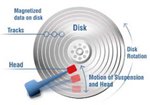Measuring & Optimizing I/O Performance
By Ilya Grigorik on June 23, 2009
 Measuring and optimizing IO performance
Measuring and optimizing IO performance
is somewhat of a black art: the tools are there, the resources and discussions are plenty, but it is also incredibly easy to get lost in the forest. I speak from recent experience. Having gone down multiple false starts with filesystem optimization, RAID tweaking,
and even app-level changes it really helped to finally step back and revisit the basics. Many man pages and discussion threads later, a few useful realizations emerged: iostat is your best friend, but it can also be incredibly deceiving; refreshing your memory
of disk latencies will go a long way; disks and filesystems are fast, but not that fast.
Monitoring IO Performance with iostat
If IO performance is suspect, iostat is your best friend. Having said that, the man pages are cryptic so don't be surprised if you find
yourself reading the source. To get started, identify the device in question and start a monitoring process:
# -k output rates in kB
# -x output extended stats
# -d monitoring single device
# sample stats every 5 seconds for device /dev/sdh
$ iostat -dxk /dev/sdi 5
Next, allocate yourself a couple of hours to understand the output or expect to find yourself down a wrong path in no time flat (been there, done that). iostat is a popular tool amongst the database crowd, so not surprisingly you'll find a lot of great discussions documenting the
use. Depending on your application you will need to focus on different metrics, but as a gentle introduction let's take a look at await, svctime and avgque:
- await - The average time (in milliseconds) for I/O requests issued to the device to be served. This includes the time spent by the requests in queue and the time spent servicing them.
- svctime - The average service time (in milliseconds) for I/O requests that were issued to the device.
- avgqu-sz - The average queue length of the requests that were issued to the device.

First off, await is a deceiving metric! Even though it claims to measure average time, it is better understood
as an aggregate function, so don't be mislead by it: avgqu-sz * svctm / (%util/100). Ideally, await should be roughly equal to your svctime, which leads us to a corollary: your average queue size is ideally
hovering around single digits. Understanding these variables alone can tell you volumes about the application generating the load.
Disk Latencies Refresher & EBS Performance
 Disk access
Disk access
time is determined via the sum of several variables: spin-up, seek, rotational delay, and transfer time. Assuming your disk is not is not sleeping we can discount the spin-up
time, which leaves us with seek (time for the disk arm to find the track: ~10ms), rotational
delay (time to get the right sector under the head: depends on RPM), and the actual transfer time. Hence, in the worst case we will take ~10ms to seek, 60s/7200RPM ~= 8ms in rotational delay, plus the read time. On average, for a 7.2k RPM
disk this translates into roughly ~5ms access time (~20ms in worst case) to read the first byte!
Armed with this knowledge we can now put Amazon's EBS performance in context: on average our EBS mounts show 10~30ms svctime, which all things considered is not outrageous for a SAN. This number also dips into low single digits at nights and on weekends,
which points to the fact that as with any shared resource, the performance of EBS degrades during the day.
Having said that, a 6x performance difference based on time of day is definitely not anything to sneeze at, so let's hope Amazon is on top of this!
Average queue size (avgqu-sz) is a popular metric in the DBA circles, but do be
careful with it when
running on a SAN or any multi-spindle device. Ideally, your queue size (avgqu-sz) for a single disk should be in single digits, which means that the underlying device is well matched to the IO load generated by the application. Conversely,
if the queue size is artificially low, chances are your application code can benefit from some tuning: do less disk flushing, think about caching or buffering, or in other words, double check the assumption that IO is the bottleneck!
Disks, Filesystems and Facebook Case Study: Haystack
 Average access time on our disks places some hard
Average access time on our disks places some hard
limits on the number of IOPs - at 5ms average, we get a very optimistic 200 req/s with no read time. Hence, if you're trying to store several hundred files a second, you might want to revisit the architecture or seriously think about switching to SSD's! Databases
such as MySQL work around this constraint by minimizing the number of file handles, caching data, and using aggressive buffering techniques. Willing to potentially loose a little bit of data with InnoDB? Set flush_log_at_trx_commit
to 2 to avoid flushing on every transaction in favor of a periodic one second flush. In similar fashion, you can tweak your MyISAM key
buffers, or even place your index and data files on different drives.
Facebook team recently released the details of their Haystack photo storage system which serves as a great case study
of working around the IO bottlenecks: over 15PB of photo storage, and ~360 new photos being uploaded every second as of April '09. To meet the requirements, they dropped the POSIX filesystem semantics and went for an append only structure with a separate in-memory
index which stores the direct inode offsets for each photo. As a result, each photo access is translated into a single IO request - a huge win. Read through it, fascinating
stuffand an illustrative example of optimizing for IO.

Ilya Grigorik is a web performance engineer and developer advocate on the Make The Web Fast team
at Google, where he spends his days and nights on making the web fast and driving adoption of performance best practices.
Follow @igrigorik
Measuring & Optimizing I/O Performance的更多相关文章
- Optimizing Item Import Performance in Oracle Product Hub/Inventory
APPLIES TO: Oracle Product Hub - Version 12.1.1 to 12.1.1 [Release 12.1] Oracle Inventory Management ...
- PatentTips - Optimizing Write Combining Performance
BACKGROUND OF THE INVENTION The use of a cache memory with a processor facilitates the reduction of ...
- [Forward]Improving Web App Performance With the Chrome DevTools Timeline and Profiles
Improving Web App Performance With the Chrome DevTools Timeline and Profiles We all want to create h ...
- Java性能提示(全)
http://www.onjava.com/pub/a/onjava/2001/05/30/optimization.htmlComparing the performance of LinkedLi ...
- Migrating Oracle on UNIX to SQL Server on Windows
Appendices Published: April 27, 2005 On This Page Appendix A: SQL Server for Oracle Professionals Ap ...
- (转) [it-ebooks]电子书列表
[it-ebooks]电子书列表 [2014]: Learning Objective-C by Developing iPhone Games || Leverage Xcode and Obj ...
- 数据库调优过程(一):SqlServer批量复制(bcp)[C#SqlBulkCopy]性能极低问题
背景 最近一段给xx做项目,这边最头疼的事情就是数据库入库瓶颈问题. 环境 服务器环境:虚拟机,分配32CPU,磁盘1.4T,4T,5T,6T几台服务器不等同(转速都是7200r),内存64G. 排查 ...
- 跨过slf4j和logback,直接晋级log4j 2
今年一直关注log4j 2,但至今还没有出正式版.等不及了,今天正式向大家介绍一下log4j的升级框架,log4j 2. log4j,相信大家都熟悉,至今对java影响最大的logging系统,至今仍 ...
- 论文笔记:Model-Agnostic Meta-Learning for Fast Adaptation of Deep Networks
Model-Agnostic Meta-Learning for Fast Adaptation of Deep Networks ICML 2017 Paper:https://arxiv.org/ ...
随机推荐
- RecyclerView 设置item间隔的方法
RecyclerView大家常用,但是如何给加载出来的item增加间隔很多人都不知道,下面是方法,直接上代码了: LinearLayoutManager layoutManager = new Lin ...
- tomcat文件夹没有部署项目和Tomcat中webapps中没有运行项目-上传下载文件和图片
1.eclipse不像MyEclipse默认将项目部署到tomcat安装目录下的webapps中,而默认部署到工作目录下的.metadata.plugins\org.eclipse.wst.serve ...
- JS中的普通函数和箭头函数
最近被问到了一个问题: >javaScript 中的箭头函数 (=>) 和普通函数 (function) 有什么区别? 我当时想的就是:这个问题很简单啊~(flag),然后做出了错误的回答 ...
- docker工作流程
Docker提供一种方法在容器中运行安全隔离的应用程序,应用程序与所有依赖项和库一起打包在容器中.因为你的应用程序总是可以使用它在构建镜像中期望的环境运行,测试和部署比以往任何时候都更简单,因为你的构 ...
- Unity 3D Framework Designing(1)—— MVVM 模式的设计和实施(Part 1)
初识 MVVM 谈起 MVVM 设计模式,可能第一映像你会想到 WPF/Sliverlight,他们提供了的数据绑定(Data Binding),命令(Command)等功能,这让 MVVM 模式得到 ...
- 安装prometheus+grafana监控mysql redis kubernetes等
1.prometheus安装 wget https://github.com/prometheus/prometheus/releases/download/v1.5.2/prometheus-1.5 ...
- Oracle DQL查询语言整理
select * from t_hq_ryxx; select nianl, xingm from t_hq_ryxx; select nianl as 年龄, xingm as 姓名 from t_ ...
- ubuntu用不了root用户:~$ su - root Password: su: Authentication failure怎么办?
解除root锁定,为root用户设置密码. 打开终端输入:sudo passwd Password: <--- 输入你当前用户的密码 Enter new UNIX password: <- ...
- Uva 11076 Add Again (数论+组合数学)
题意:给你N个数,求把他们的全排列加和为多少 思路:对于这道题,假设数字k1在第一位,然后求出剩下N-1位的排列数num1,我们就可以知道k1在第一位时 排列有多少种为kind1, 同理,假设数字k2 ...
- WPF 杂谈——开篇简言。
这俩年多来笔者一直在从事关于WPF的开发.虽然不能说是专家级别的.但是对于WPF的应用还是有一定的了解.论他的灵活性决对不在WinForm之下.WPF的出现更是引发一段热议.他的何去何从更是让很多人感 ...
